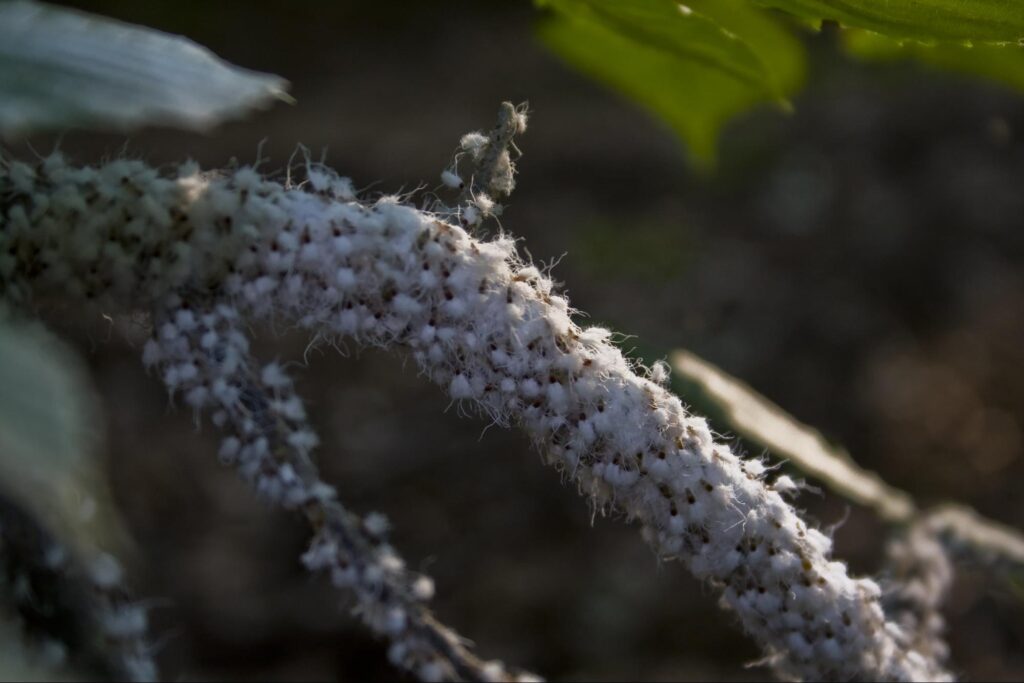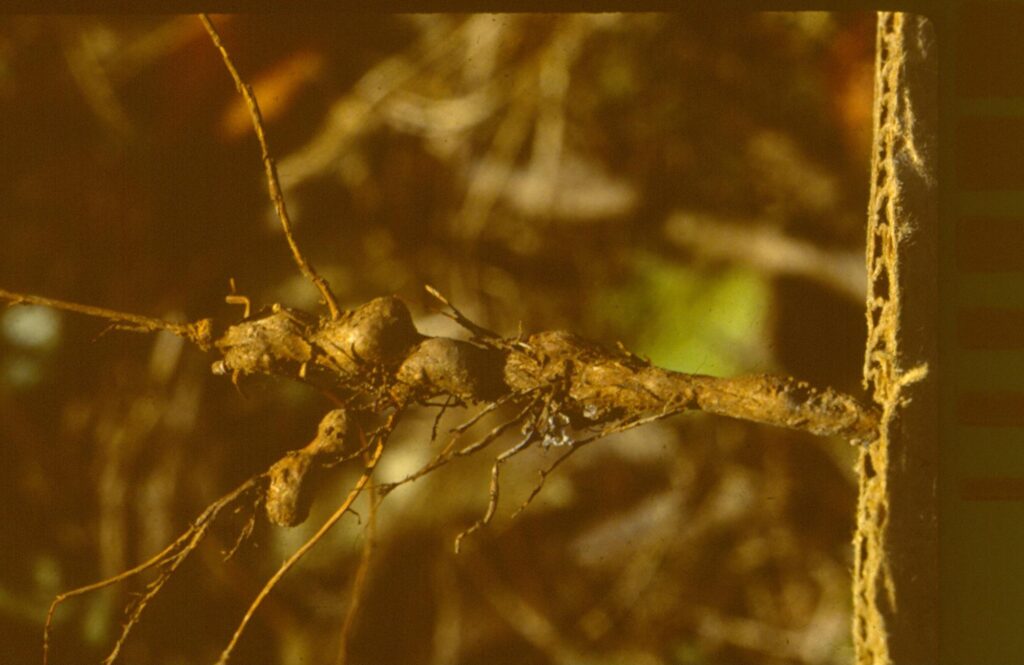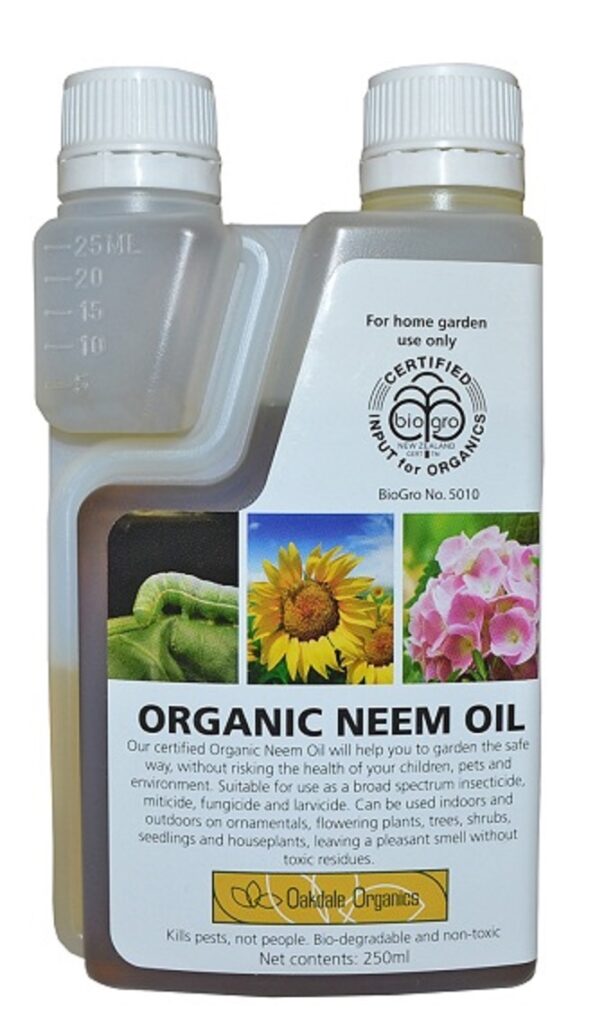White fuzzy jumping bug on plants is woolly aphids that infest their hosts in large colonies and feed on the sweet sugary sap. This pest is serious across the globe, with severe infestations on hardwood, coniferous trees, and shrub species.

There are many ways by which these fuzzy white bugs can be killed or eliminated. However, the best practice to get rid of their infestations on host plants involves the applications of neem oil, insecticidal soap, and vegetable oils.
Keep reading this write-up to learn about white fuzzy bugs and how we can get rid of them to maintain healthy plants.
What Are Woolly Aphids?
The woolly aphid (Eriosoma lanigerum) is a severe pest of trees, shrubs, and coniferous trees. Like all soft-bodied pests, the woolly aphid sucks out plant fluids and reduces plant vigor to fight back. Their infestations are more severe in the North American region and spread to other plants and parts of the world through infested rootstocks.

The woolly aphid also infests peach (can transmit deadly viruses), roses, and quince plants, reducing their flowers and fruit production.

They appear as white furry stuff with waxy coverings on indoor and outdoor plants. Antennas of the woolly aphid have bands with veins on their wings. On host plants, their presence confuses the growers with mealy bug and scale insects because of sticky honeydew secretions.
The woolly aphid also secretes white fuzzy stuff, termed woolly. The primary purpose of this white waxy fluff is for protection from natural predators, chemical contact, and systemic insecticide. The actual body beneath this white fuzzy stuff is pear-shaped with orange, brown, and black color bodies.
RELATED: Aphids on Indoor Houseplants: 10+ Smart Ways to Get Rid of Them!
Damage Caused By Woolly Aphids
Like all other aphids, this black or brown aphid becomes active during spring and feeds on new growths—stems, thinner branches, leaves, and flower buds. The feeding damage of black aphids resembles fungal diseases and mealybug feeding.

The woolly aphid or black aphids are sap-sucking insects and feed on the plant sap. While some species have a broader host range, some aphids feed only on one or two plant species.

One of the visible signs of the feeding damage of the woolly aphid or American blight is stunted growth. Even their small numbers can wreak havoc on young plants. However, they can hardly damage the established fruit or citrus trees.
They prefer to extract sap from plant stems and move towards flower buds and thinner branches during heavy infestations.

Black aphids continuously feed on sugary plant sap and excrete sweet honeydew on indoor plants and an entire tree. These sugary secretions assist the growth of black sooty mold fungus and black ants.
Most importantly, the sooty mold fungus grew on sugary honeydew and covered the whole leaf surface with black spore masses. These spore masses prevent sunlight absorption by leaves and reduce the plant’s vigor.

The symptoms of the woolly aphid infestations are;
- As the white bugs feed on host plant stems, they cause swollen and irregular growth underneath the infested bark. The swellings rupture during frosty winter weather and expose the plant tissues to fungal diseases.
- The white bugs mainly infest the trunks and freshly pruned branches during spring.
- The weak or thinner branches with old pruning cuts are prime feeding sites for white fluffy bugs and then spread to younger shoots.
- Fuzzy white bugs damage includes poor foliage growth, branch dieback, and development of cankers on apple fruit and galls on roots.

Life Cycle Of Fuzzy White Bugs
White fuzz insects have two host plants to complete their life cycle. One host overwinters while the second host plant feeds during the summertime. These white insects overwinter as eggs or nymphs in the winter host plant’s bark, crack, and crevices.

During springtime, the eggs hatch into parthenogenic females, which can give birth to many wingless nymphs, and populations grow thrice within days. After two generations on the winter host, the winged females are produced that dispersed to the summer host plant.
These female white bugs spend the whole summer on the host plant while sucking out nutrients from food tissues and giving live birth to wingless youngs. Summertime is the peak season for their generations and the aphids complete multiple generations per plant.
As the fall approaches, the particular kind of winged females fly back to winter host and give birth to males and females. After mating, the female deposit its eggs in the bark of the winter host plant and dies.
How To Get Rid Of White Fuzzy Bugs?
Aphids reproduce quickly during the growing season of plants. They can reach hundreds of numbers within days and damage the entire plant badly. Once their populations are high, challenging to control aphids. So, detecting and preventing these white flies’ infestations is essential before they kill the plant.
There are many ways to get rid of white fuzzy bugs, such as;
Non-Chemical Control
- In the case of little white bug infestations, knock them down with the help of a garden hose with a high stream of water or remove them with a stiff-bristled brush.
- Apply liquid dish soap spray on indoor plants frequently until they are dead and fall to the ground.
- Encourage natural predators of aphids such as lady beetle, green lacewings, and predatory wasps. Other insects which feed on aphids include earwigs that can keep the aphid populations under control. However, the parasitic wasps are the most effective among the natural predators because they deposit their eggs in the adult and nymph stages. When the eggs hatch, larvae feed on the body fluids of aphid and kills them.
- Prune off the thinner branches and weak leaves of the winter host plant and treat the cuts with insecticide and fungicide to deter infestations
- For new plants or succulents, position them in direct sunlight during the morning when the light intensity is not harsh and carefully monitor them for the woolly aphid eggs and nymphs.
- Spray the indoor plants with neem oil during the growing season (spring and summer). First, prepare the neem oil mixture by adding one tablespoon of neem oil with dish soap and per liter of water. Pour the solution into a spray bottle and apply to prevent mealybugs and fluffy aphids.
- Primarily, apply on the underside of leaves because aphids and mealybugs thrive on the bottom of leaves.
- Spray plant with any horticultural oils to smother the aphids. Make sure to reapply after two days to eradicate them.

RELATED: How to Use Neem Oil for Plants as an Organic Pesticide? Plus, Amazing Benefits!
Chemical Control
The chemical control of the woolly aphid involves the use of organic sprays such as pyrethrum (Bug Clear Gun), plant oil (Vitax Plant Guard), and fatty acids (Blackfly Killer). Insecticidal sprays are more compulsory when the aphid populations are high, and you want to kill them instantly to prevent losses of flower buds and leaves.
You can also spray your plant with Orthene—specifically effective for the woolly aphid populations.
Frequently Asked Questions
What Spray Kills The Woolly Aphid?
Several insecticides are available on the market to get rid of aboveground infestations. It consists of Diazinon, Closer, Beleaf, Movento, and Admire Pro sprays that effectively control the woolly aphid on thinner branches and pruning cuts, flower buds, and stems. However, no commercially available insecticides to control root infestations on apple trees, maple, and peaches.
Where Did The Woolly Aphid Come From?
Infestations of the woolly aphid are more common on apples and other edible plants. In spring, the overwintering eggs hatch into young nymphs, leading to the first generation of aphids. The larvae extract plant juices and harm the new growth and leaves.
All the aphids from winter eggs are females, and these female aphids can give birth to live nymphs. These female aphids live for twenty-five days and can produce 80 nymphs.
What Is A Fairy Bug?
A fairy bug is a chalcid wasp (fairyflies) that are parasites and deposit their eggs in various insects. They play the role of beneficial insects for farmers and indoor plant owners.
Are Woolly Aphids Invasive?
The woolly aphids are invasive and deadly on fruit trees and flowering plants. They extract sap from plant tissues and seriously threaten fruit yield.
What Trees Do Woolly Aphids like?
The woolly aphid infestation is most common on edible apple trees, pyracantha, and Cotoneaster. They cover their bodies with white powdery fluff and confuse the growers with fungal infections.
How Do You Control Woolly Apple Aphids?
The applications of insecticidal soap on a smaller scale or little infestations are most helpful and practical. It controls and keeps the number of pests at a minimum level.
While for heavy infestations, spray your apple trees with Closer, Beleaf, Movento, and Admire Pro. These insecticides are only practical for aboveground aphid control but not for root infestations.
What Is The Best Aphid Killer?
The best aphid killers are rubbing alcohol, insecticidal soap, and plant-based horticultural oils. Insecticidal soaps deter the hard covering of insect bodies and kill them within eight hours of application. At the same time, horticultural oils block the oxygen supply and kill the insect.
Do Ladybugs Eat The Woolly Aphid?
Ladybugs prefer to eat aphids and can feast on almost 50 per day. They prey on all stages of aphids and help growers control pests in a non-toxic way. In addition to ladybugs, the aphids have many natural predators such as green lacewings, hoverflies, parasitic wasps, earwigs, and many species of birds.
Plant flowering plants to encourage these natural enemies because they visit gardens to collect nectars. On the other hand, to attract beneficial birds to the park, provide them with a nest or homes and feed.
Sources For Further Reading
- [email protected]. (2021, December 22). Woolly Alder Aphid (Family Aphididae). Field Station. Retrieved June 13, 2022, from https://uwm.edu/field-station/woolly-alder-aphid/
- Bessin, R., & Hartman, J. (n.d.). Woolly Apple Aphid | Entomology. University of Kentucky College of Agriculture. Retrieved June 13, 2022, from https://entomology.ca.uky.edu/ef219
Lewis, D. (2012). Woolly Aphids — Interesting but Messy. Horticulture and Home Pest News. Retrieved June 13, 2022, from https://hortnews.extension.iastate.edu/2012/6-27/woollyaphids.html







